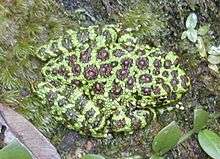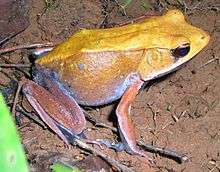True frog
The true frogs, family Ranidae, have the widest distribution of any frog family. They are abundant throughout most of the world, occurring on all continents except Antarctica. The true frogs are present in North America, northern South America, Europe, Africa (including Madagascar), and Asia. The Asian range extends across the East Indies to New Guinea and a single species (the Australian wood frog (Hylarana daemelii)) has spread into the far north of Australia.
| True frogs | |
|---|---|
 | |
| Common frog (Rana temporaria) | |
| Scientific classification | |
| Kingdom: | Animalia |
| Phylum: | Chordata |
| Class: | Amphibia |
| Order: | Anura |
| Suborder: | Neobatrachia |
| Clade: | Ranoidea |
| Family: | Ranidae Rafinesque, 1814 |
| Synonyms | |
|
See text | |
Typically, true frogs are smooth and moist-skinned, with large, powerful legs and extensively webbed feet. The true frogs vary greatly in size, ranging from small—such as the wood frog (Lithobates sylvatica)—to large.
Many of the true frogs are aquatic or live close to water. Most species lay their eggs in the water and go through a tadpole stage. However, as with most families of frogs, there is large variation of habitat within the family. There are also arboreal species of true frogs, and the family includes some of the very few amphibians that can live in brackish water.[1]
Systematics
The subdivisions of the Ranidae are still a matter of dispute, although most are coming to an agreement. Several former subfamilies are now recognised as separate families (Petropedetidae, Cacosterninae, Mantellidae, and Dicroglossidae). The genus Rana has now been split up and is much reduced in size.
While too little of the vast diversity of true frogs has been subject to recent studies to say something definite, as of mid-2008, studies are going on, and several lineages are recognizable.[2][3][4]
- The genus Staurois is probably a very ancient offshoot of the main Raninae lineage.
- Amolops has been generally delimited as a monophyletic group.
- Odorrana and Rana plus some proposed minor genera (which probably ought to be included in the latter) form another group.
- A group including Clinotarsus, Huia in the strict sense and Meristogenys
- An ill-defined assemblage of Babina, Glandirana, Hylarana, Pulchrana, Sanguirana, and Sylvirana, as well as Hydrophylax and Pelophylax, which are probably not monophyletic. Some authorities have treated them as junior synonyms of the genus Hylarana.[5]
Genera


Most of the subfamilies formerly included under Ranidae are now treated as separate families, leaving only Raninae remaining. The following genera are recognised in the family Ranidae:
- Abavorana Oliver, Prendini, Kraus, and Raxworthy, 2015
- Amnirana Dubois, 1992
- Amolops Cope, 1865
- Babina Thompson, 1912
- Chalcorana Dubois, 1992
- Clinotarsus Mivart 1869
- Glandirana Fei, Ye, and Huang, 1990
- Huia Yang, 1991
- Humerana Dubois, 1992
- Hydrophylax Fitzinger, 1843
- Hylarana Tschudi 1838
- Indosylvirana Oliver, Prendini, Kraus, and Raxworthy, 2015
- Lithobates Fitzinger, 1843
- Meristogenys Yang, 1991
- Nidirana Dubois, 1992
- Odorrana Fei, Ye, and Huang, 1990
- Papurana Dubois, 1992
- Pelophylax Fitzinger 1843
- Pseudorana Fei, Ye, and Huang, 1990
- Pterorana Kiyasetuo and Khare, 1986
- Pulchrana Dubois, 1992
- Rana Linnaeus, 1758
- Sanguirana Dubois, 1992
- Staurois Cope, 1865
- Sumaterana Arifin, Smart, Hertwig, Smith, Iskandar, and Haas, 2018
- Sylvirana Dubois, 1992
Incertae sedis
A number of taxa are placed in Ranidae incertae sedis, that is, their taxonomic status is too uncertain to allow more specific placement.
- "Hylarana" attigua (Inger, Orlov, and Darevsky, 1999)
- "Hylarana" celebensis (Peters, 1872)
- "Hylarana" chitwanensis (Das, 1998)
- "Hylarana" garoensis (Boulenger, 1920)
- "Hylarana" lateralis (Boulenger, 1887)
- "Hylarana" latouchii (Boulenger, 1899)
- "Hylarana" margariana Anderson, 1879
- "Hylarana" montivaga (Smith, 1921)
- "Hylarana" persimilis (Van Kampen, 1923)
References
- Gordon, Malcolm S.; Schmidt-Nielsen, Knut; Kelly, Hamilton M. (1961): Osmotic Regulation in the Crab-Eating Frog (Rana cancrivora). J. Exp. Biol. 38 (3): 659–678. PDF fulltext
- Cai, Hong-xia; Che, Jing; Pang, Jun-feng; Zhao, Er-mi; Zhang, Ya-ping (2007): Paraphyly of Chinese Amolops (Anura, Ranidae) and phylogenetic position of the rare Chinese frog, Amolops tormotus. Zootaxa 1531: 49–55. PDF fulltext
- Kotaki, Manabu; Kurabayashi, Atsushi; Matsui, Masafumi; Khonsue, Wichase; Djong, Tjong Hon; Tandon, Manuj; Sumida, Masayuki (2008): Genetic Divergences and Phylogenetic Relationships Among the Fejervarya limnocharis Complex in Thailand and Neighboring Countries Revealed by Mitochondrial and Nuclear Genes. Zool. Sci. 25 (4): 381–390. doi:10.2108/zsj.25.381 (HTML abstract)
- Stuart, Bryan L. (2008): The phylogenetic problem of Huia (Amphibia: Ranidae). Mol. Phylogenet. Evol. 46 (1): 49-60. doi:10.1016/j.ympev.2007.09.016 PDF fulltext
- Amphibian Species of the World 5.5, an Online Reference. "Hylarana Tschudi, 1838". American Museum of Natural History.
- Cogger, H.G.; Zweifel, R.G.; Kirschner, D. (2004): Encyclopedia of Reptiles & Amphibians (2nd ed.). Fog City Press. ISBN 1-877019-69-0
- Frost, Darrel R. (2006): Amphibian Species of the World Version 3 - Petropedetidae Noble, 1931. American Museum of Natural History, New York, USA. Retrieved 2006-AUG-05.
- Frost, Darrel R. et al. (2006): The amphibian tree of life. Bulletin of the American Museum of Natural History. Number 297. New York.
- Hillis, D.M. (2007) Constraints in naming parts of the Tree of Life. Mol. Phylogenet. Evol. 42 (2): 331–338. doi:10.1016/j.ympev.2006.08.001 PDF fulltext
- Hillis, D.M.; Wilcox, T.P. (2005): Phylogeny of the New World true frogs (Rana). Mol. Phylogenet. Evol. 34 (2): 299–314. doi:10.1016/j.ympev.2004.10.007 PDF fulltext
- Pauly, Greg B.; Hillis, David M.; Cannatella, David C. (2009): Taxonomic freedom and the role of official lists of species names. Herpetologica 65: 115-128.
- Rafinesque, C.S. (2007): "Fine del prodromo d'erpetologia siciliana ". Specchio delle Scienze, o, Giornale Enciclopedico di Sicilia 2: 102-104. (Ranidae, new family). (in Italian).